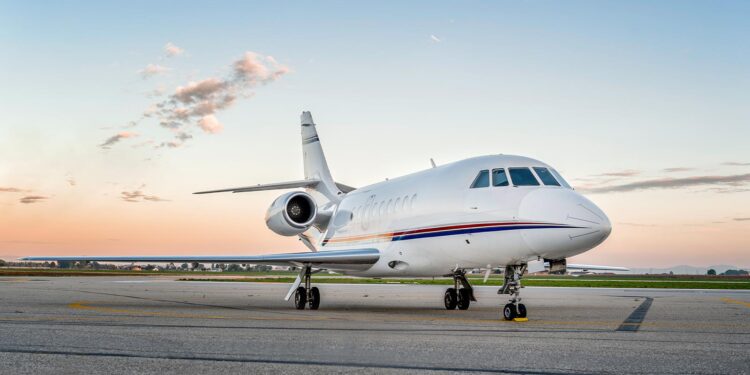Business Aircraft Operations to Tianjin, China: Part 1 – Airport Basics

This is a post by author Jimmy Young. Jimmy serves as country manager for Universal Aviation China, which has aircraft ground handling facilities in Beijing, Shanghai, and Guangzhou. Jimmy is an expert on business aircraft operations in China and can be contacted at jimmyyoung@universalaviation.aero.
This business aviation blog post is part of a series on operations to Tianjin, China.
Tianjin (ZBTJ) is the preferred alternate airport for Beijing (ZBAA). It’s a good place to reposition if you require longer-term parking and additional operating flexibility. As ZBAA becomes more and more congested and restrictive, the ZBTJ option has been growing in popularity with many international business aircraft operators.
The following is an overview of what you need to know when operating to ZBTJ:
1. Tianjin basics
ZBTJ is a 24-hour airport of entry located 67 NM from ZBAA – about a 20-minute flight. This location has plenty of aircraft parking with no restrictions in terms of length of stay. Wide-body General Aviation (GA) aircraft are welcome at ZBTJ, with prior permission from the Civil Aviation Administration of China.
2. Easy connections to Beijing
The best option for crews who reposition to ZBTJ and plan to travel to Beijing is to arrange prepaid transport (car with driver) via your ground handler. There’s also a high-speed train between central Tianjin and Beijing — which takes just 40 minutes, but this service is not 24 hours, and the last train is about 2300 local.
3. Ground handling and ground support equipment availability
There’s no fixed-base operator or general aviation terminal at ZBTJ, and local handlers at this location are airline handlers working for the airport authority. Most operators choose to bring in a supervisory handling agent from Beijing – who has greater familiarity with GA’s unique requirements – in order to overcome language barriers and to better oversee handling. It’s best to provide at least 24 hours’ advance notification, or make arrangements as soon as your schedule is known, to arrange a supervisory handling agent to reposition to ZBTJ. While handling services at ZBTJ are available 24 hours, additional charges are applicable for night operations 2200-0700 local. Note that you’ll need to pay an airport fee and an “additional manpower surcharge” for night arrivals/departures. While the quality of local handling services at ZBTJ is not to the standards of ZBAA or Shanghai Hongqiao (ZSSS), there’s a good selection of GA-suited ground support equipment available – including tow bars, ground power units, air stairs, etc.
4. The captain must go to the tower to sign the flight plan
For all operations at ZBTJ, the captain must personally go to the tower to sign off on the flight plan. Your ground handler cannot do this for you. It’s important to plan additional time to accomplish this step.
5. Private vehicles on the ramp
Prior to the 2008 Beijing Olympics, it was possible with prior arrangement to bring private vehicles on the ramp at ZBAA and ZBTJ. This policy has since changed, and private vehicle rampside access is no longer permitted.
6. In-flight catering considerations
There’s only one in-flight caterer at ZBTJ, and at least 24 hours’ advance notification is recommended for in-flight catering requests. Be aware that the in-flight caterer available at this airport offers very limited choices for VIP operations, and quality is not considered up to GA standards. The best option is to source catering from local restaurants and to work with your ground handler to bring catering through airport security.
7. Hotel options
While there are 3-and 4-star hotel options available near the airport at ZBTJ, you’ll find better 4-and 5-star hotels, with improved selections of restaurants, in central Tianjin. Expect to pay crew rates of 150 USD per night for 4-star accommodations, and about 200 USD per night for 5-star hotels. Many crews who reposition to ZBTJ for more than a couple of nights choose to travel to, and stay in, the Beijing area.
8. Weather issues
Weather in Tianjin is similar to Beijing. There can be haze and visibility issues in the summer, fog that may last 6-12 hours during the autumn, and snowfall during winter. Be aware that de-icing services at ZBTJ are not of the same standards as at ZBAA. Commercial airlines have priority, and you can expect delays if de-icing services are required.
9. Fuel and credit
Fuel is delivered by truck to your parking location, and hydrant fuel is available at some parking spots. It’s always recommended to carry a fuel release when operating to this location. Your ground handler can arrange credit with prior arrangement, for all airport and handling-related charges.
Conclusion
ZBTJ has the advantage of being only about half the cost of operating to ZBAA, and the operating situation here is much more flexible. ZBAA, for example, has a GA curfew from 0700-0900 local, and only one movement (takeoff or landing) is permitted during peak hours of 0800-2200 local. Additionally, GA aircraft can usually only stay on the ground up to 48 hours at ZBAA. None of these operating restrictions exist at ZBTJ.
Questions?
If you have any questions about this article or would like assistance planning your next trip to China, contact Christine Vamvakas christinevamvakas@univ-wea.com.
Stay tuned for Part 2, which covers permit, visa, and customs information for Tianjin.




